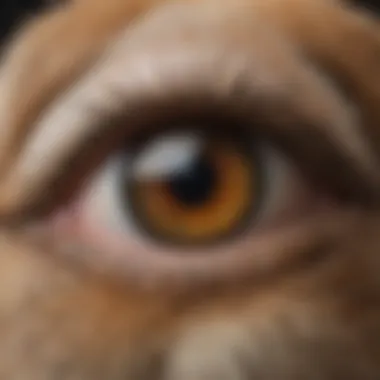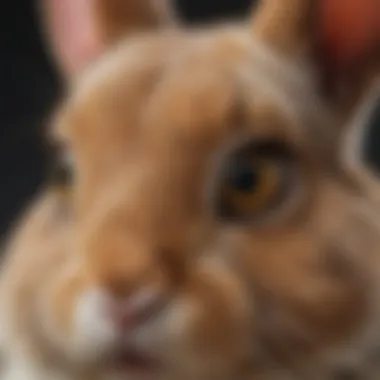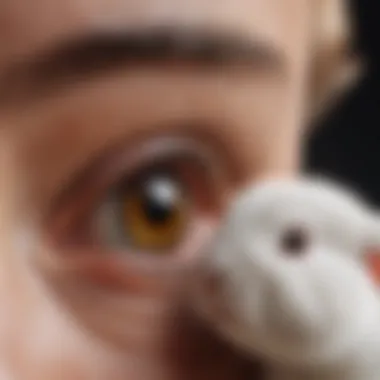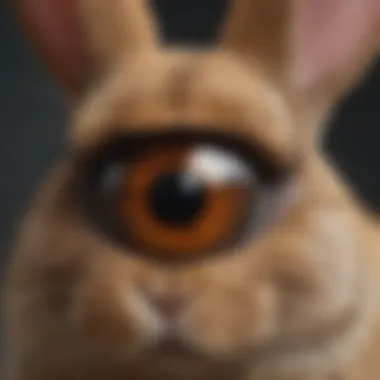Understanding Rabbit Eye Discharge: Causes and Treatment


Intro
When it comes to our furry companions, understanding their health is crucial. Rabbits are unique animals with specific needs. One important aspect of their health is eye discharge. Recognizing the difference between normal and abnormal discharge can make a significant difference in safeguarding your pet's health. This article explores the causes, diagnosis, and treatment of eye discharge in rabbits, aiming to inform pet owners about this often-overlooked health issue.
Understanding Your Pet
Caring for a rabbit involves more than just feeding and shelter. It requires a solid understanding of their nature and requirements.
Pet Behavior Basics
Rabbits are social animals that prefer living in pairs. This social structure influences their behavior. They can exhibit signs of distress if left alone for long periods. Eye discharge can sometimes indicate stress or discomfort. Observing your rabbit's behavior can help detect abnormalities early.
Common Breed Characteristics
Different breeds may have varied tendencies regarding health issues. For example, breeds such as Angora and Holland Lop might be more prone to certain eye conditions. Being aware of these characteristics can guide you to monitor their health closely.
Species-Specific Needs
Rabbits have distinct dietary and environmental needs. They thrive in a clean and safe environment. Poor living conditions can contribute to eye problems. Ensuring that your rabbit’s habitat is hygienic is vital for their overall health and wellbeing.
Health and Wellness
Regular health check-ups are essential for rabbits, just as for other pets.
Routine Vet Check-ups
Taking your rabbit to the veterinarian regularly can help catch potential issues early. Veterinarians can also provide valuable insight into breed-specific health concerns.
Vaccination Needs
Rabbits require specific vaccinations to protect them from common diseases. Staying updated with vaccinations reduces health risks and can prevent complications that might lead to eye discharge.
Recognizing Signs of Illness
Pet owners should familiarize themselves with signs of illness, including eye discharge. Normal discharge can occur, but persistent or colored discharge warrants a visit to the veterinarian. Monitoring your rabbit’s overall behavior can also provide clues. If they are lethargic, not eating, or showing signs of discomfort, it may signify an underlying health problem.
Culmination
Understanding eye discharge in rabbits is crucial for their health. Knowing when to seek veterinary care, combined with routine check-ups and awareness of each species’ specific needs, contributes to better health for your pet. Keeping an eye on changes in behavior, diet, or physical appearance allows for timely interventions, ensuring a long and happy life for your rabbit.
Foreword to Rabbit Eye Discharge
Rabbit eye discharge is an issue that can significantly impact the overall well-being of pet rabbits. Understanding this phenomenon is crucial for pet owners and caretakers. Eye health in rabbits often serves as an indicator of their general health. When discharge occurs, it can signal underlying health problems or stressors that need to be addressed promptly. This article seeks to illuminate various aspects of eye discharge specifically in rabbits, offering insights that are both informative and applicable to everyday care.
Definition of Eye Discharge
Eye discharge, also known as ocular discharge, refers to the fluid or mucus that can accumulate in or around the eyes. This fluid can vary in consistency and color, and it may differ depending on the underlying cause. Each rabbit may exhibit unique traits in their discharge, which can often be informative in diagnosing specific issues. Common types include watery discharge, sticky mucus, and even crusty residue forming around the eye.


Monitoring eye discharge is essential for recognizing possible problems early. If pet owners notice changes in the discharge's character, it could indicate a more serious condition requiring veterinary attention. Spotting these changes can be the first step in prevention and treatment.
Significance of Monitoring Eye Health
Regular observation of a rabbit's eyes and their discharge is significant for several reasons.
- Early Detection: Keeping an eye on discharges can help in identifying issues before they escalate. Early detection of problems such as infections or allergy reactions can lead to prompt treatment, enhancing the chance of recovery.
- Overall Health Indicator: Rabbits are adept at hiding pain or discomfort. Changes in eye discharge may reveal internal health issues that need addressing. By assessing the state of the eyes, pet owners gain insight into the rabbit's overall health status.
- Routine Care: Establishing a routine for monitoring eye health integrates smoothly into overall pet care. It encourages a proactive approach, helping to foster a stronger bond between the pet and owner.
In summary, understanding rabbit eye discharge is vital not only for immediate health concerns but also for ensuring long-term wellness. Engaging with this topic equips pet owners with knowledge that can make a tangible difference in their pet's life.
Normal vs.
Abnormal Eye Discharge
The distinction between normal and abnormal eye discharge in rabbits is crucial in understanding their overall health. Eye discharge can be a common occurrence in rabbits, but differentiating between what is typical and what signals a potential health issue is essential for pet owners. An accurate interpretation of these signs can lead to prompt treatment and better outcomes for the animal. This knowledge not only empowers pet owners but also establishes a routine care approach that prioritizes eye health in rabbits.
Characteristics of Normal Discharge
Normal eye discharge in rabbits is typically clear or slightly cloudy. This kind of discharge should not produce any odor and is often minimal. The eyes may appear strong and bright, without signs of swelling or irritation around them. In this context, a few specific characteristics are important to note:
- Color: Often clear or pale yellow.
- Quantity: Minimal and sporadic.
- Texture: Fluid and not sticky or crusty.
- Accompanied Symptoms: None; the rabbit remains energetic and behaves normally.
This type of discharge can often be attributed to environmental factors or natural tear production. As a pet owner, knowing these indicators helps ensure that you are not overreacting to benign conditions.
Indicators of Abnormal Discharge
Abnormal eye discharge varies significantly from normal discharge and often indicates underlying health issues. Recognizing these signs can be life-saving for your rabbit. Some key indicators to watch for include:
- Color Changes: Thick or yellow-green discharge often suggests an infection.
- Increased Quantity: A noticeable increase in discharge volume may point to discomfort or distress.
- Consistency: Sticky or crusty textures often suggest problems that need veterinary attention.
- Accompanied Symptoms: These might include squinting, swelling, or redness around the eyes, and behavioral changes such as lethargy or decreased appetite.
A prompt veterinary visit is necessary if the eye discharge appears abnormal. Early detection can lead to effective treatment and recovery.
In summary, while normal discharge can be an ordinary aspect of a rabbit's physiology, abnormal discharge typically warrants immediate attention. Knowing the differences assists pet owners in making informed decisions about their rabbit's health, thus enhancing the quality of life for these beloved companions.
Common Causes of Eye Discharge in Rabbits
Understanding the common causes of eye discharge in rabbits is essential for pet owners. This knowledge helps in early detection of health issues and intervention when necessary. Eye discharge can indicate various underlying conditions, some of which may require immediate veterinary attention. Recognizing the different potential causes can empower owners to act suitably, ensuring the health and well-being of their pets.
Infections: Bacterial and Viral
Infections are frequent culprits in cases of eye discharge in rabbits. Both bacterial and viral infections can cause significant changes in eye health.
Bacterial infections, such as conjunctivitis, arise when harmful bacteria invade the eye area. Symptoms typically include redness, swelling, and discharge that may be yellow or green in color. It is crucial to take prompt action by visiting a veterinarian when these signs appear.
Viral infections, on the other hand, can stem from several sources. One common virus affecting rabbits is the Myxoma virus. This viral cause often presents similar symptoms but may involve additional systemic problems. Identifying the root cause is vital for effective treatment, as differing infections require tailored strategies.
Allergic Reactions


Allergic reactions also lead to eye discharge in rabbits. Just like humans, rabbits can react to allergens. Common triggers include pollen, dust mites, and certain foods. The discharge due to allergies may be clear and watery. Observing your rabbit's environment can give clues. If symptoms coincide with specific changes around the home, it may be time to address the allergens. Consultation with a veterinarian can help in determining appropriate measures for managing the allergy.
Environmental Irritants
Rabbits are sensitive creatures. Environmental irritants such as smoke, strong odors, and fumes can irritate their eyes. Such irritants can result in excessive tearing and discharge. It is essential to keep your rabbit's living space free from these irritants. Proper ventilation and avoiding smoking or using strong cleaning products around rabbits can significantly improve their eye health. Monitoring the rabbit's reactions to their surroundings will aid in identifying potential sources of irritation.
Dental Issues
Dental health plays a crucial role in overall rabbit well-being. Dental issues, like overgrown teeth, can lead to secondary eye discharge. When teeth grow improperly, they can misalign, leading to pain or infection, which may manifest as watery eyes or discharge. Regular dental check-ups are important to ensure that your rabbit’s teeth are in good condition. Look out for signs like difficulty eating or visible tooth problems that might indicate a visit to the vet is necessary.
Foreign Bodies
Foreign bodies can cause immediate concern. If a rabbit gets a small piece of hay or other material stuck in its eye, it may result in excess discharge. Observing your rabbit for behaviors, such as pawing at its eyes or squinting, can help identify if something is lodged there. If you suspect a foreign body, it is best to seek veterinary assistance right away, as prompt removal is crucial to prevent further harm.
Diagnosis of Eye Discharge in Rabbits
Diagnosing eye discharge in rabbits is a critical part of ensuring their overall health. The eyes of these pets are sensitive and can indicate various underlying problems. Correct diagnosis is essential for effective treatment and to prevent complications. Early detection of abnormalities can often lead to better outcomes and can spare the rabbit from unnecessary discomfort.
Initial Veterinary Assessment
During the initial veterinary assessment, the veterinarian will gather important information regarding the rabbit's health history. Observations of the eye discharge, including color, consistency, and the duration of the symptoms, help the vet narrow down potential causes. The veterinary professional will also perform a general examination of the rabbit. This includes checking for signs of distress, examining the eyes closely, and assessing overall body condition. Notably, the vet may look for other symptoms that could accompany eye discharge, such as sneezing, coughing, or changes in appetite. This comprehensive approach ensures that any factors contributing to the discharge are considered, allowing for a well-informed diagnosis.
Diagnostic Tests
After the initial assessment, the veterinarian may recommend specific diagnostic tests to gain deeper insights into the underlying issue. Common diagnostic tests include:
- Cultures and Sensitivity Tests: These help identify bacterial infections, which can then be targeted with appropriate antibiotics.
- Fluorescein Staining: This test checks for corneal ulcers or abrasions, which can be a cause of excessive tear production.
- Bloodwork: A complete blood count (CBC) can assess the rabbit's overall health and detect infections or systemic issues.
- Imaging: X-rays or ultrasounds may be used in some cases to evaluate dental issues or other internal problems that could be affecting the eyes.
These tests can provide a more accurate picture of what is happening with the rabbit's health and allow for tailored treatment efforts. Diagnosis cannot be rushed, as an errant conclusion could result in ineffective or harmful treatments.
Importance of Accurate Diagnosis
Accurate diagnosis of the cause of eye discharge is crucial. Misdiagnosis can lead to inappropriate treatments, which may worsen the rabbit's condition. For example, administering antibiotics for a viral infection will not address the underlying problem. Moreover, some causes of eye discharge can escalate into more serious health issues if not correctly identified. For example, dental disease can lead to significant pain and systemic health problems if left untreated.
In summary, securing an accurate diagnosis sets the foundation for effective treatment,
an early diagnosis can improve prognosis and enhance the rabbit's quality of life.
Pet owners should always seek veterinary care when they observe abnormal eye discharge. This proactive approach to health can prevent small issues from becoming significant challenges.
Treatment Options for Eye Discharge
Addressing eye discharge effectively is crucial for maintaining the overall health of rabbits. The treatment options available range from minor interventions to significant medical procedures. Understanding these various treatment modalities allows pet owners to take informed steps toward managing their rabbit's eye health. Each treatment comes with its benefits, considerations, and potential impacts on the rabbit's well-being.
Topical Therapies
Topical therapies, including eye drops and ointments, are often the first line of treatment for eye discharge in rabbits. They directly address local issues in or around the eye, providing targeted relief. Common medications include:


- Antibiotic ointments for bacterial infections
- Antihistamines for allergic reactions
- Lubricating drops to soothe irritation
These treatments can be straightforward to apply, but it is essential to ensure proper techniques to avoid causing stress to the rabbit. Owners should also monitor any changes in the discharge to observe the effectiveness of the therapy. Prompt attention to ocular health can prevent minor issues from escalating into severe conditions.
Systemic Medications
In cases where localized treatment proves inadequate, systematic medications may be required. These medications, typically in the form of oral tablets or injections, address more extensive issues affecting the rabbit's overall health. Bacterial or viral infections might necessitate antibiotics or antiviral drugs respectively. Common considerations include:
- Duration of treatment to avoid drug resistance
- Side effects that could impact the rabbit
- The importance of a follow-up veterinary appointment to gauge effectiveness
Using systemic therapies can potentially cure underlying issues causing eye discharge, making them a vital tool in the veterinary arsenal. Proper dosage and administration are critical to ensure the rabbit's safety and effective treatment outcomes.
Surgical Interventions
In some cases, surgical interventions become essential to manage eye discharge. Procedures may be necessary for conditions like:
- Removal of foreign bodies obstructing the eye
- Corrective surgery for anatomical deformities
- Drainage of abscesses or excessive tear production
Surgical solutions tend to be more invasive and may require anesthesia, thus posing greater risks. Post-operative care is as crucial as the procedure itself, so owners must remain vigilant about recovery signs. Surgical options should be discussed thoroughly with a veterinarian to weigh risks against the potential benefits to the rabbit's health.
Regular veterinary check-ups are fundamental to maintaining eye health, preventing minor ailments from exacerbating into more serious concerns.
Effective treatment of eye discharge in rabbits requires a comprehensive approach, emphasizing proper diagnosis and tailored care. Combining these treatment options with awareness of preventative measures ensures rabbits maintain optimal eye health.
Preventative Care and Eye Health Maintenance
Preventative care is crucial for maintaining the overall health of rabbits, and eye health is no exception. Rabbits are gentle creatures that require regular attention to prevent health issues that could lead to serious complications. Understanding the significance of eye health maintenance can lead to a better quality of life for pet rabbits.
Regular Veterinary Check-Ups
Routine veterinary check-ups are key for early detection of eye problems. During these visits, a veterinarian will conduct a thorough examination of the rabbit’s eyes. This includes checking for any signs of discharge, redness, or other abnormalities. Regular health assessments also provide opportunities for vaccinations, which can prevent illnesses that may impact eye health. Keeping a schedule for these check-ups helps ensure that any potential issues are caught early, thus improving treatment chances should an issue arise.
Environmental Considerations
The environment in which a rabbit lives greatly affects its eye health. Dust, pollen, and other airborne irritants can cause discomfort and lead to eye discharge. It is important to maintain a clean living space for your rabbit. Regular cleaning of the bedding and cage can minimize the risk of eye-related issues. Additionally, ensuring that the rabbit's habitat is free from potential irritants like strong-smelling chemicals or smoke is vital for preventing allergic reactions and other environmental stressors.
Diet and Nutrition
A well-balanced diet plays a crucial role in eye health maintenance. Rabbits require a diet rich in fiber, vitamins, and minerals to support their overall health, including their eyes. Fresh vegetables, hay, and specially formulated rabbit pellets should be included in their daily meals. Beta-carotene found in carrots and greens can help in maintaining eye health. Monitoring the diet can prevent nutritional deficiencies that might lead to eye health problems.
Ensure your rabbit receives a balanced diet for optimal eye health. Regularly review feeding practices and adjust where necessary.
Finale
Understanding eye discharge in rabbits is crucial for their overall health and well-being. Pet owners need to recognize the significance of both normal and abnormal discharges. By monitoring their rabbits closely, one can identify potential health issues early. This can lead to timely interventions that may prevent serious complications.
Summary of Key Points
- Types of Discharge: Differentiating between normal and abnormal eye discharge is essential. Normal discharge does not indicate health concerns, while abnormal discharge could signal infections, allergies, or other issues.
- Common Causes: Infections, dental problems, environmental irritants, and foreign bodies are prevalent causes of eye discharge in rabbits. Understanding these can help owners assess their pets more effectively.
- Diagnosis and Treatment: Accurate diagnosis is key. Regular veterinary visits, alongside diagnostic tests, help in identifying the root cause. Treatment options vary from topical therapies to medications and potential surgical interventions.
- Preventative Measures: Regular check-ups and maintaining a clean environment are vital for preventive care. Moreover, balanced nutrition contributes to a rabbit’s eye health.
Encouragement for Proactive Care
Pet owners should be proactive in caring for their rabbits. Setting a routine for observation can help in early detection of any discharge issues. If any abnormalities arise, consulting a veterinarian without delay is beneficial. Education about their specific health needs can empower owners to provide better care.
Being informed leads to better health management of rabbits. It also enables owners to engage more meaningfully with their pets, fostering a healthier and happier life together. For more resources on pet care, consider visiting Wikipedia or engaging with communities on Reddit.







